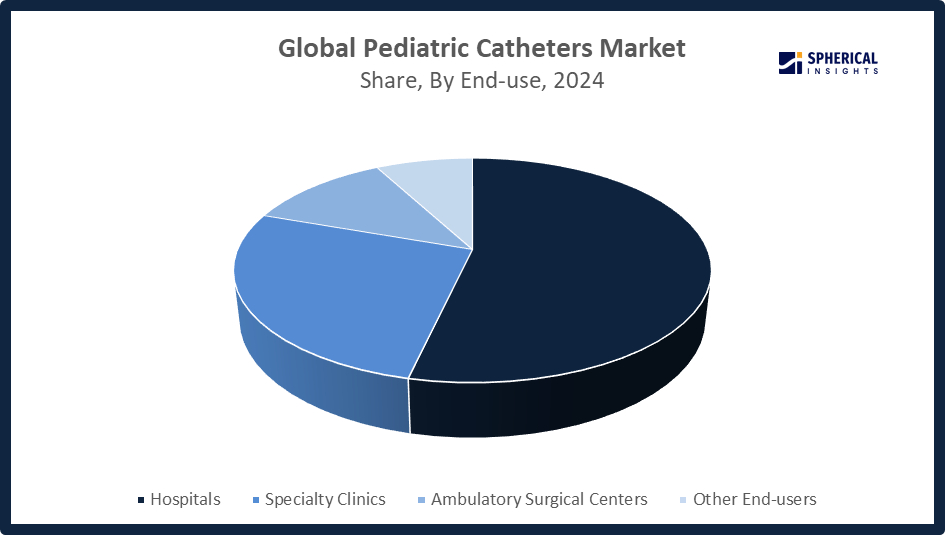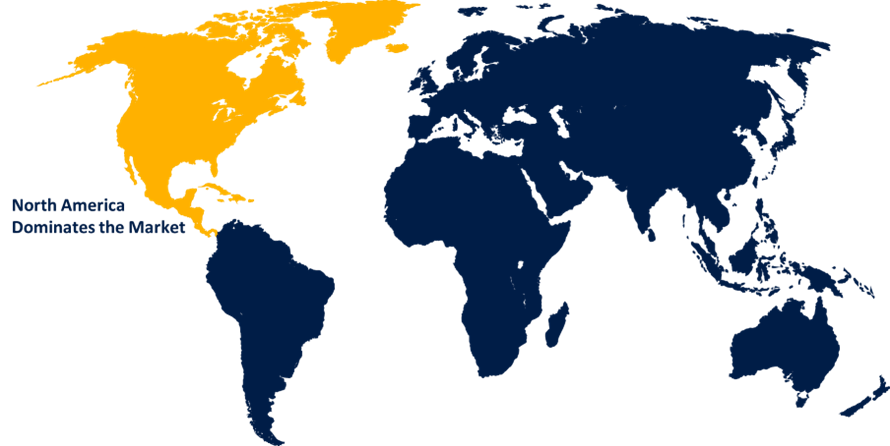Global Pediatric Catheters Market Size, Share, and COVID-19 Impact Analysis, By Product Type (Cardiovascular Catheters, Urology Catheters, Intravenous Catheters, Neurovascular Catheters, and Specialty Catheters), By Material (Polyvinyl Chloride, Silicone, Polyurethane, Latex, and Other Materials), By End-Use (Hospitals, Specialty Clinics, Ambulatory Surgical Centers, and Other End-users), and By Region (North America, Europe, Asia-Pacific, Latin America, Middle East, and Africa), Analysis and Forecast 2025 - 2035
Industry: HealthcareGlobal Pediatric Catheters Market Insights Forecasts to 2035
- The Global Pediatric Catheters Market Size Was Estimated at USD 8.51 Billion in 2024
- The Market Size is Expected to Grow at a CAGR of around 9.1% from 2025 to 2035
- The Worldwide Pediatric Catheters Market Size is Expected to Reach USD 22.18 Billion by 2035
- Asia Pacific is expected to grow the fastest during the forecast period.

Get more details on this report -
According to a research report published by Spherical Insights and Consulting, The Global Pediatric Catheters Market Size was worth around USD 8.51 Billion in 2024 and is predicted to grow to around USD 22.18 Billion by 2035 with a compound annual growth rate (CAGR) of 9.1% from 2025 to 2035. The market for pediatric catheters is increasing due to the increasing incidence of pediatric urological and cardiovascular disorders, increasing minimally invasive surgery procedures, developing catheter technology, rising healthcare provider awareness, and increasing hospital infrastructure within developing countries.
Market Overview
The global pediatric catheters market is defined as the business sector that produces, distributes, and uses specialized catheters for children and infants. These devices are mostly applied in medical procedures such as urinary drainage, cardiovascular procedures, intravenous treatments, and minimally invasive surgical interventions. The Pediatric Catheters are specifically made smaller, flexible, and biocompatible to the adult type to provide comfort and safety for children. Their uses range across cardiology, urology, neurology, and intensive care and treat congenital abnormalities, urinary diseases, and other medical conditions in children. Market expansion is fueled by the increasing incidence of diseases among children, such as congenital heart diseases, urinary tract infections, and neurological ailments, boosted by rising healthcare consciousness and growing pediatric populations worldwide. Technological advancements have increasingly driven adoption, with examples such as 3D-printed stents, polymeric catheters, and minimally invasive designs improving safety, precision, and procedure efficiency.
Government programs, research grants, and supportive regulations in markets such as North America, Europe, and the Asia Pacific also drive market growth by encouraging pediatric medical research and enhancing access to specialized healthcare solutions. Emerging economies with growing pediatric healthcare infrastructure, combined with investments in smart hospitals and neonatal care units, are expansion opportunities. Top players such as Teleflex, Becton Dickinson, Medtronic, and Cook Medical are emphasizing product innovation, inorganic growth, strategic alliances, and expansion to consolidate their presence globally. Six pediatric cardiology innovators were awarded $50,000 each on October 14 in Toronto through the Make Your Medical Device Pitch for Kids! Competition, which was half-funded by the U.S. Food and Drug Administration (FDA). With about 40,000 children born annually with congenital heart defects, personalized medical devices are needed since most devices available today have been created for older adult patients.
Report Coverage
This research report categorizes the pediatric catheters market based on various segments and regions, forecasts revenue growth, and analyzes trends in each submarket. The report analyses the key growth drivers, opportunities, and challenges influencing the pediatric catheters market. Recent market developments and competitive strategies such as expansion, type launch, development, partnership, merger, and acquisition, have been included to draw the competitive landscape in the market. The report strategically identifies and profiles the key market players and analyses their core competencies in each sub-segment of the pediatric catheters market.
Global Pediatric Catheters Market Report Coverage
| Report Coverage | Details |
|---|---|
| Base Year: | 2024 |
| Market Size in 2024: | USD 8.51 Billion |
| Forecast Period: | 2025-2035 |
| Forecast Period CAGR 2025-2035 : | 9.1% |
| 2035 Value Projection: | USD 22.18 Billion |
| Historical Data for: | 2020-2023 |
| No. of Pages: | 190 |
| Tables, Charts & Figures: | 123 |
| Segments covered: | By Product Type, By Material, By End-Use and By Region |
| Companies covered:: | Medtronic, Abbott, Boston Scientific Corporation, Cook Medical, Johnson & Johnson, Smiths Medical, BD (Becton, Dickinson and Company), Cardinal Health, ICU Medical, Inc., Terumo Corporation, Getinge AB, B. Braun Melsungen, Coloplast Corp, Edwards Lifesciences Corporation, and Others |
| Pitfalls & Challenges: | COVID-19 Empact, Challenges, Future, Growth, & Analysis |
Get more details on this report -
Driving Factors
The global demand for pediatric catheters is propelled by the higher incidence of congenital heart malformations, urinary tract diseases, and neurological disorders in children, which increases demand for advanced medical devices. Increased use of minimally invasive techniques in pediatric therapy decreases recovery time and complications, increasing demand for catheters. Improved technology, such as smaller, more flexible, and biocompatible catheters, improves safety and efficacy. Increased pediatric healthcare infrastructure in emerging markets, supported by government incentives and research funding, also propels market growth. Moreover, increased awareness among caregivers and healthcare professionals regarding early diagnosis and treatment also provides a stimulus to the adoption of pediatric catheters globally.
Restraining Factors
The pediatric catheters market is challenged by high device pricing, limited reimbursement in some geographies, and complications of infection or vascular damage. Further, a lack of trained healthcare practitioners for pediatrics, strict regulatory clearances, and low penetration in less developed regions hamper widespread usage and growth in the market.
Market Segmentation
The pediatric catheters market share is classified into product type, material, and end-use.
- The cardiovascular catheters segment dominated the market in 2024, approximately 40% and is projected to grow at a substantial CAGR during the forecast period.
Based on the product type, the pediatric catheters market is divided into cardiovascular catheters, urology catheters, intravenous catheters, neurovascular catheters, and specialty catheters. Among these, the cardiovascular catheters segment dominated the market in 2024 and is projected to grow at a substantial CAGR during the forecast period. This segment dominated the worldwide growth in the pediatric catheters market is based on enhanced prevalence of congenital heart disease in children, growing demands for minimally invasive cardiac interventions, and technological advancements in catheter technologies such as flexible, biocompatible, and precision-engineered designs. Moreover, higher awareness among caregivers and healthcare providers regarding early diagnosis, successful treatment options, and enhanced pediatric cardiac care fuels continual growth in the market.
- The polyurethane segment accounted for the largest share in 2024, approximately 45% and is anticipated to grow at a significant CAGR during the forecast period.
Based on the material, the pediatric catheters market is divided into polyvinyl chloride, silicone, polyurethane, latex, and other materials. Among these, the polyurethane segment accounted for the largest share in 2024 and is anticipated to grow at a significant CAGR during the forecast period. This segment growth in the pediatric catheters market is fueled by polyurethane's greater biocompatibility, flexibility, and strength, due to which it finds itself well-suited to highly sensitive pediatric procedures, such as cardiovascular and urinary intervention. Furthermore, the growing use of minimally invasive procedures and the growing demand for long-lasting, safe catheter materials also augment market growth.
- The hospitals segment accounted for the highest market revenue in 2024, approximately 54% and is anticipated to grow at a significant CAGR during the forecast period.
Based on the end-use, the pediatric catheters market is divided into hospitals, specialty clinics, ambulatory surgical centers, and other end-users. Among these, the hospitals segment accounted for the highest market revenue in 2024 and is anticipated to grow at a significant CAGR during the forecast period. The hospitals segment in the pediatric catheters market is growing due to the world being fueled by the availability of sophisticated pediatric care centers, high volumes of intricate cardiac, urological, and neurovascular procedures, and increased availability of advanced catheter technologies. Higher investments in hospital facilities and increased demand for minimally invasive pediatric therapy further drive market growth.

Get more details on this report -
Regional Segment Analysis of the Pediatric Catheters Market
- North America (U.S., Canada, Mexico)
- Europe (Germany, France, U.K., Italy, Spain, Rest of Europe)
- Asia-Pacific (China, Japan, India, Rest of APAC)
- South America (Brazil and the Rest of South America)
- The Middle East and Africa (UAE, South Africa, Rest of MEA)
North America is anticipated to hold the largest share of the pediatric catheters market over the predicted timeframe.

Get more details on this report -
North America is anticipated to hold the largest share of the pediatric catheters market over the predicted timeframe. North America is expected to dominate the pediatric catheters market during the forecast period, approximate market share of 35%, attributed to superior healthcare facilities, high presence of prominent medical device companies, and enhanced uptake of novel pediatric technology. The United States leads the regional market owing to large-scale research funding, favorable FDA programs such as the Pediatric Device Consortia Program, and increased demand for minimally invasive pediatric procedures. Canada also plays an important role, backed by increasing investments in child healthcare, enhancing hospital infrastructure, and government-supported programs enhancing neonatal and pediatric treatment accessibility.
Asia Pacific is expected to grow at a rapid CAGR in the pediatric catheters market during the forecast period. Asia Pacific is rapidly growing in the pediatric catheters market during the forecast period, with approximately 21% of market share, supported by enhanced healthcare infrastructure, rising pediatric populations, and higher government investments in neonatal and child healthcare initiatives. China dominates the market with growing pediatric hospitals and such initiatives as Healthy China 2030. India, fuelled by the National Health Mission and accelerating hospital modernization, comes next. Japan and South Korea lead by virtue of technological innovation and mature pediatric healthcare systems, fueling regional development.
The market for pediatric catheters in Europe is expanding steadily, with Germany, France, and the UK taking the lead. It is fuelled by developed healthcare infrastructure, robust government support, and early diagnosis campaigns for pediatric illnesses. Investments in minimally invasive technology and funding in the form of efforts such as Horizon Europe drive growth. Further, increasing pediatric cardiac and urological ailments and greater hospital uptake of specialist catheters bolster Europe's position in the international pediatric catheters market.
Competitive Analysis:
The report offers the appropriate analysis of the key organizations/companies involved within the pediatric catheters market, along with a comparative evaluation primarily based on their type of offering, business overviews, geographic presence, enterprise strategies, segment market share, and SWOT analysis. The report also provides an elaborative analysis focusing on the current news and developments of the companies, which includes type development, innovations, joint ventures, partnerships, mergers & acquisitions, strategic alliances, and others. This allows for the evaluation of the overall competition within the market.
List of Key Companies
- Medtronic
- Abbott
- Boston Scientific Corporation
- Cook Medical
- Johnson & Johnson
- Smiths Medical
- BD (Becton, Dickinson and Company)
- Cardinal Health
- ICU Medical, Inc.
- Terumo Corporation
- Getinge AB
- B. Braun Melsungen
- Coloplast Corp
- Edwards Lifesciences Corporation
- Others
Key Target Audience
- Market Players
- Investors
- End-users
- Government Authorities
- Consulting and Research Firm
- Venture capitalists
- Value-Added Resellers (VARs)
Recent Development
- In September 2025, Johnson & Johnson launched the Shockwave Javelin Peripheral IVL Catheter in Europe. This novel intravascular lithotripsy platform modifies calcium in severely narrowed vessels for peripheral artery disease (PAD) treatment, featuring a single lithotripsy emitter and comparable safety and effectiveness to legacy Shockwave IVL catheters.
- In August 2025, the U.S. FDA approved Cook Medical to begin an Investigational Device Exemption (IDE) study for the Advanced Evero 18 Everolimus Coated PTA Balloon Catheter (Evero DCB). The study will evaluate its safety and effectiveness versus paclitaxel-coated balloons in treating peripheral artery disease (PAD).
- In May 2025, Boston Scientific Corporation announced the U.S. and European launches of the Sterling SL PTA Balloon Dilatation Catheter. This high-performance catheter is designed for peripheral angioplasty procedures below the knee, with immediate market introduction planned in both regions.
- In May 2025, Abbott launched the TactiFlex Sensor-Enabled Ablation Catheter, the world’s first ablation catheter with a flexible tip and contact force technology, designed to treat arrhythmias such as atrial fibrillation (AFib), a condition caused by irregular electrical impulses leading to abnormal heart rhythm and serious complications.
- In February 2022, Medtronic plc announced that its Freezor and Freezor Xtra Cardiac Cryoablation Focal Catheters became the first and only FDA-approved ablation catheters for treating pediatric Atrioventricular Nodal Reentrant Tachycardia (AVNRT), addressing the growing prevalence of this heart condition in children.
Market Segment
This study forecasts revenue at global, regional, and country levels from 2020 to 2035. Spherical Insights has segmented the pediatric catheters market based on the below-mentioned segments:
Global Pediatric Catheters Market, By Product Type
- Cardiovascular Catheters
- Urology Catheters
- Intravenous Catheters
- Neurovascular Catheters
- Specialty Catheters
Global Pediatric Catheters Market, By Material
- Polyvinyl Chloride
- Silicone
- Polyurethane
- Latex
- Other Materials
Global Pediatric Catheters Market, By End-use
- Hospitals
- Specialty Clinics
- Ambulatory Surgical Centers
- Other End-users
Global Pediatric Catheters Market, By Regional Analysis
- North America
- US
- Canada
- Mexico
- Europe
- Germany
- UK
- France
- Italy
- Spain
- Russia
- Rest of Europe
- Asia Pacific
- China
- Japan
- India
- South Korea
- Australia
- Rest of Asia Pacific
- South America
- Brazil
- Argentina
- Rest of South America
- Middle East & Africa
- UAE
- Saudi Arabia
- Qatar
- South Africa
- Rest of the Middle East & Africa
Frequently Asked Questions (FAQ)
-
1. What is the CAGR of the pediatric catheters market over the forecast period?The global pediatric catheters market is projected to expand at a CAGR of 9.1% during the forecast period.
-
2. What is the pediatric catheters market?The pediatric catheters market is the global industry for producing and selling medical catheters specifically designed for newborns and children.
-
3. What is the market size of the pediatric catheters market?The global pediatric catheters market size is expected to grow from USD 8.51 billion in 2024 to USD 22.18 billion by 2035, at a CAGR of 9.1% during the forecast period 2025-2035.
-
4. Which region holds the largest share of the pediatric catheters market?North America is anticipated to hold the largest share of the pediatric catheters market over the predicted timeframe.
-
5. Who are the top 10 companies operating in the global pediatric catheters market?Medtronic, Abbott, Boston Scientific Corporation, Cook Medical, Johnson & Johnson, Smiths Medical, BD (Becton, Dickinson and Company), Cardinal Health, ICU Medical, Inc., Terumo Corporation, Getinge AB, B. Braun Melsungen, Coloplast Corp, Edwards Lifesciences Corporation, and Others.
-
6. What factors are driving the growth of the pediatric catheters market?The pediatric catheters market is growing due to the increasing prevalence of chronic and congenital conditions, technological advancements in catheter design and materials, and the expansion of neonatal and pediatric intensive care units (NICUs and PICUs).
-
7. What are the market trends in the pediatric catheters market?Market trends in pediatric catheters include a growing demand driven by the rising prevalence of chronic diseases like congenital heart defects and neurological disorders, an increase in minimally invasive procedures, and technological advancements in materials and design.
-
8. What are the main challenges restricting wider adoption of the pediatric catheters market?The wider adoption of pediatric catheters is restricted by technological limitations, the risk of catheter-related complications, stringent regulations, high costs, and a lack of specialized clinical expertise.
Need help to buy this report?